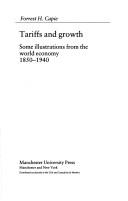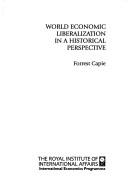| Listing 1 - 10 of 41 | << page >> |
Sort by
|
Book
ISBN: 0043303382 Year: 1983 Publisher: London Allen & Unwin
Abstract | Keywords | Export | Availability | Bookmark
 Loading...
Loading...Choose an application
- Reference Manager
- EndNote
- RefWorks (Direct export to RefWorks)
History of the United Kingdom and Ireland --- anno 1930-1939 --- anno 1920-1929

ISBN: 1852784024 9781852784027 Year: 1991 Volume: 1 Publisher: Aldershot : Edward Elgar,
Abstract | Keywords | Export | Availability | Bookmark
 Loading...
Loading...Choose an application
- Reference Manager
- EndNote
- RefWorks (Direct export to RefWorks)
Money. Monetary policy --- World history --- Inflation (Finance) --- History. --- 338 <09> --- 336.748.12 --- -AA / International- internationaal --- 331.157 --- 331.156 --- 331.150 --- 333.841 --- -332.41 --- Finance --- Natural rate of unemployment --- Economische geschiedenis --- Algemeen prijsniveau. Prijsindex. Prijsstijging --- History --- Geldwezen sedert 1945. --- Geldwezen van 1914 tot 1945. --- Geschiedenis van het geldwezen: algemeenheden. --- Inflatie. --- 336.748.12 Algemeen prijsniveau. Prijsindex. Prijsstijging --- 338 <09> Economische geschiedenis --- 332.41 --- AA / International- internationaal --- Geschiedenis van het geldwezen: algemeenheden --- Geldwezen van 1914 tot 1945 --- Geldwezen sedert 1945 --- Inflatie --- Inflation (Finance) - History. --- Inflation --- Histoire

ISBN: 0255365063 9780255365062 Year: 2002 Volume: 64 1 Publisher: London,
Abstract | Keywords | Export | Availability | Bookmark
 Loading...
Loading...Choose an application
- Reference Manager
- EndNote
- RefWorks (Direct export to RefWorks)

ISBN: 071903938X 9780719039386 Year: 1994 Publisher: Manchester Manchester university press
Abstract | Keywords | Export | Availability | Bookmark
 Loading...
Loading...Choose an application
- Reference Manager
- EndNote
- RefWorks (Direct export to RefWorks)
Tariff --- Protectionism --- Economic history --- History. --- 338 <09> --- 330.35 --- 339.545 --- Economische geschiedenis --- Economische groei. Kwantitatieve toename. Technische vooruitgang --zie ook {338.09} --- Boycot. Contingentering. Handelsbelemmering. Embargo. Handelsoorlog. Protectionisme. Discriminatie. Autarchie --- 339.545 Boycot. Contingentering. Handelsbelemmering. Embargo. Handelsoorlog. Protectionisme. Discriminatie. Autarchie --- 330.35 Economische groei. Kwantitatieve toename. Technische vooruitgang --zie ook {338.09} --- 338 <09> Economische geschiedenis --- Ad valorem tariff --- Border taxes --- Customs (Tariff) --- Customs duties --- Duties --- Fees, Import --- Import controls --- Import fees --- Tariff on raw materials --- Commercial policy --- Indirect taxation --- Revenue --- Customs administration --- Favored nation clause --- Non-tariff trade barriers --- Reciprocity (Commerce) --- Free trade and protection --- History --- Tariff - History. --- Protectionism - History. --- Economic history - 1750-1918. --- Economic history - 1918-1945.

ISBN: 0521496349 0521065461 0511983697 9780521496346 9780511983696 9780521065467 Year: 1994 Publisher: Cambridge : Cambridge University Press,
Abstract | Keywords | Export | Availability | Bookmark
 Loading...
Loading...Choose an application
- Reference Manager
- EndNote
- RefWorks (Direct export to RefWorks)
This volume contains two major papers prepared for the Bank of England's Tercentenary Symposium in June 1994. The first, by Forrest Capie, Charles Goodhart and Norbert Schnadt, provides an authoritative account of the evolution of central banking. It traces the development of both the monetary and financial stability concerns of central banks, and includes individual sections on the evolution and constitutional positions of 31 central banks from around the world. The second paper, by Stanley Fischer, explores the major policy dilemmas now facing central bankers: the extent to which there is a short-term trade-off between inflation and growth; the choice of inflation targets; and the choice of operating procedures. Important contributions by leading central bankers from around the world, and the related Per Jacobsen lecture by Alexander Lamfalussy, are also included in the volume.
336.71 (410) --- 333.111.1 --- -332.11 --- Bankwezen--?<410> --- Organieke wetten en statuten van centrale banken. --- 336.71 (410) Bankwezen--?<410> --- Banks and banking, Central --- Monetary policy --- 332.11 --- banque centrale --- 331.162.21 --- 333.110 --- 333.111.0 --- GB / United Kingdom - Verenigd Koninkrijk - Royaume Uni --- Congresses --- centrale bank --- Geschiedenis van de centrale banken --- Centrale banken en parastatale kredietinstellingen: algemeen. Overheidsbemoeiïng inzake organisatie en verdeling van het krediet --- Algemeenheden. Theoretische en beschrijvende studies. Centrale banken --- Organieke wetten en statuten van centrale banken --- Money. Monetary policy --- Congresses. --- Banques centrales --- Politique monétaire --- Congrès --- Banks and banking [Central ] --- Labor economics. --- Inflation --- Business, Economy and Management --- Economics --- Unemployment
Book
ISBN: 9781139077576 1139077570 9780521192828 052119282X 9780511761478 0511761473 9781107621695 1107621690 1107204429 1139063073 1283112337 9786613112330 1139075314 1139079867 1139082132 1139069543 Year: 2010 Publisher: Cambridge : Cambridge University Press,
Abstract | Keywords | Export | Availability | Bookmark
 Loading...
Loading...Choose an application
- Reference Manager
- EndNote
- RefWorks (Direct export to RefWorks)
This history of the Bank of England takes its story from the 1950s to the end of the 1970s. This period probably saw the peak of the Bank's influence and prestige, as it dominated the financial landscape. One of the Bank's central functions was to manage the exchange rate. It was also responsible for administering all the controls that made up monetary policy. In the first part of the period, the Bank did all this with a remarkable degree of freedom. But economic policy was a failure, and sluggish output, banking instability and rampant inflation characterised the 1970s. The pegged exchange rate was discontinued, and the Bank's freedom of movement was severely constrained, as new approaches to policy were devised and implemented. The Bank lost much of its freedom of movement but also took on more formal supervision.
Banks and banking, Central --- Banker's banks --- Banks, Central --- Central banking --- Central banks --- Banks and banking --- History --- Bank of England --- Governor and Company of the Bank of England --- Eiran Ginkō --- Old Lady of Threadneedle Street --- Old Lady in Threadneedle Street --- Great Britain. --- History. --- E-books --- Business, Economy and Management --- Economics --- GB / United Kingdom - Verenigd Koninkrijk - Royaume Uni --- 331.162.21 --- 331.157 --- -336.71 <09> --- 332.110941 --- 336.71 <09> Bankwezen--Geschiedenis van ... --- Bankwezen--Geschiedenis van ... --- Geschiedenis van de centrale banken --- Geldwezen sedert 1945 --- Bankwezen--Geschiedenis van --- 336.7 <09> --- 336.71 <41> --- 336.71 <41> Bankwezen--Verenigd Koninkrijk van Groot-Brittannië en Noord-Ierland --- Bankwezen--Verenigd Koninkrijk van Groot-Brittannië en Noord-Ierland --- 336.7 <09> Geschiedenis van het bankwezen --- Geschiedenis van het bankwezen --- -History

ISBN: 9780511983696 9780521496346 9780521065467 0521496349 Year: 1994 Publisher: Cambridge : Cambridge University Press,
Abstract | Keywords | Export | Availability | Bookmark
 Loading...
Loading...Choose an application
- Reference Manager
- EndNote
- RefWorks (Direct export to RefWorks)
This volume contains two major papers prepared for the Bank of England's Tercentenary Symposium in June 1994. The first, by Forrest Capie, Charles Goodhart and Norbert Schnadt, provides an authoritative account of the evolution of central banking. It traces the development of both the monetary and financial stability concerns of central banks, and includes individual sections on the evolution and constitutional positions of 31 central banks from around the world. The second paper, by Stanley Fischer, explores the major policy dilemmas now facing central bankers: the extent to which there is a short-term trade-off between inflation and growth; the choice of inflation targets; and the choice of operating procedures. Important contributions by leading central bankers from around the world, and the related Per Jacobsen lecture by Alexander Lamfalussy, are also included in the volume.

ISBN: 1862031290 Year: 2001 Publisher: London Royal Institute of International Affairs
Abstract | Keywords | Export | Availability | Bookmark
 Loading...
Loading...Choose an application
- Reference Manager
- EndNote
- RefWorks (Direct export to RefWorks)
Book
Year: 1999 Publisher: Washington, D.C. : World Bank,
Abstract | Keywords | Export | Availability | Bookmark
 Loading...
Loading...Choose an application
- Reference Manager
- EndNote
- RefWorks (Direct export to RefWorks)
November 1995 What have we learned about central banks? The principal factors affecting central bank autonomy in the past two centuries have been prevailing political conditions, a laissez faire environment, and the exchange rate regime (whether fixed or floating). Institutions we know as central banks emerged or were established as commercial banks or government banks. Their evolution into central banks came with their monopoly issuing notes and their role as lender of last resort, among other functions. Carrying out commercial business on a large scale created a conflict of interest, so this practice was abandoned. Depending on government also hindered maximum performance. Establishing the right degree of dependence was difficult, and changed in times of crisis. Independence is important: it helps to establish reputation, which is everything in banking. Independence can't be established overnight and is liable to abrupt alteration. The Great Depression, widely attributed to inept Central Bank behavior, interrupted central bank independence, but poor price behavior brought about its return. In the nineteenth century, laissez faire and the gold standard encouraged and sometimes allowed for considerable independence. After the end of the intermission of mercantilism, which arrived with World War I, preferences changed. Crisis provoked intervention. But wartime inflation and the return of peace allowed independence to return briefly. Greater changes came in the new dirigiste environment following the Great Depression and the rise of the managed economy. In the current climate -- in which market solutions are ascendant and intervention is falling out of favor -- the pendulum has swung again. Economies in transition confront high inflation and the problem of maintaining monetary stability just as newly independent developing countries did in the 1960s. How can inflation be controlled? Under fiat regimes, the money supply is controlled by the domestic monetary authority. But can they control monetary growth? Prior and current records are not encouraging. Even if authorities have good intentions, will they be believed? Credibility, so essential to success, does not come easily. Options include maintaining a fixed exchange rate or reviving currency boards. Currency boards function like an independent central bank, holding reserves and tying domestic currency to strong foreign currency. Such arrangements have succeeded, but most operated when sterling was strong. And most countries with currency boards conducted most of their trade with Britain, at least in sterling. There are drawbacks to currency boards, especially for countries in transition. They require a considerable sacrifice of sovereignty, and are unlikely to appeal to countries that are only beginning to recover lost sovereignty. This paper -- a joint product of the Finance and Private Sector Development Division, Policy Research Department, and the Financial Sector Development Department -- was presented at a Bank seminar, Financial History: Lessons of the Past for Reformers of the Present, and is a chapter in a forthcoming volume, Reforming Finance: Some Lessons from History, edited by Gerard Caprio, Jr. and Dimitri Vittas.
Book
ISBN: 0935859411 Year: 1990 Publisher: New York Stockton Press
Abstract | Keywords | Export | Availability | Bookmark
 Loading...
Loading...Choose an application
- Reference Manager
- EndNote
- RefWorks (Direct export to RefWorks)
| Listing 1 - 10 of 41 | << page >> |
Sort by
|

 Search
Search Feedback
Feedback About
About Help
Help News
News